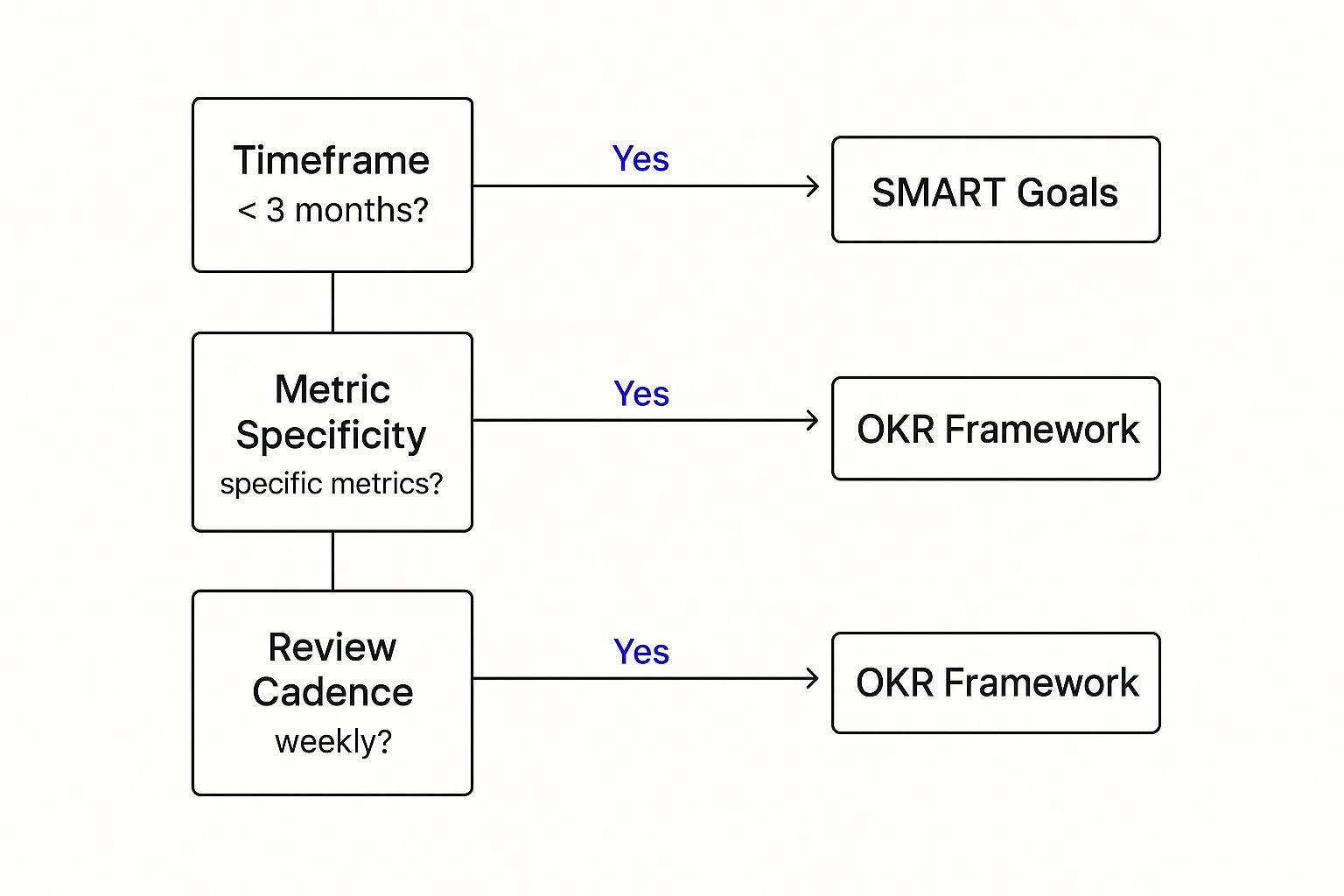Why Most Goal Setting Approaches Fail (And What Works Instead)
Let's be honest: goal setting often misses the mark. The problem usually isn't the framework itself, but how it's put into practice. Imagine forcing SMART goals onto a project that's constantly evolving. That rigidity can stifle creativity and frustrate teams who need to adapt. This mismatch leads to goals being quietly abandoned.
Ignoring the unique culture of a team is another common pitfall. Even the best frameworks will fall apart if they don't resonate with how the team operates.
Understanding project failure is key. One culprit is a weak handover process, as highlighted in this article on project handover checklists, particularly the section on why handovers often go wrong. Clear communication and structured processes are essential, even after the initial goal setting. Smooth transitions between phases are just as vital as the phases themselves, requiring a holistic approach to project management.
The history of goal setting provides valuable perspective. Philosophers like Aristotle and Plato discussed goal-directed behavior centuries ago. Modern goal-setting theory really gained momentum in the 1960s, thanks to researchers like Edwin Locke and Gary Latham, who explored the power of specific, challenging goals. The introduction of Management by Objectives (MBO) marked a significant shift during this period. You can explore this evolution further here. This ongoing search for better methods underscores the complexity of effective goal setting.
Successful goal setting isn't just about picking a trendy framework. It's about deeply understanding your team's dynamics, their work style, and the overall company culture. Different teams thrive in different environments. Some flourish with the structure of SMART goals, while others need the flexibility of OKRs. Choosing the right fit is crucial for creating a sense of ownership and driving real progress. This means understanding not just the framework, but the nuances of your team and their optimal operating style. This lays the groundwork for genuine engagement and, ultimately, success.
SMART Goals: When Structure Becomes Your Strategic Advantage
SMART goals remain relevant, not because they're a rigid formula, but because they offer a powerful framework adaptable to various situations. Their strength lies in understanding where they truly excel. For example, in heavily regulated sectors like healthcare and finance, the specific, measurable, achievable, relevant, and time-bound nature of SMART goals provides much-needed clarity and accountability. These industries often require meticulous tracking and reporting, making SMART goals a natural fit.
Project-based work also benefits significantly from this structured approach. Imagine a software development team using SMART goals to define deliverables for each sprint. The framework helps decompose complex projects into manageable steps, ensuring everyone understands their contributions and deadlines. A deeper understanding of why development teams sometimes struggle can inform our goal-setting strategies. For more on this, check out this resource on software development team structure. The clear, measurable aspects of SMART goals allow for precise progress tracking and facilitate timely adjustments as needed.
However, SMART goals are not a one-size-fits-all solution. In rapidly evolving environments requiring constant adaptation, their inherent structure can become a constraint. Consider a marketing team navigating the volatile social media landscape. Rigidly adhering to predefined, time-bound goals might prevent them from capitalizing on emerging trends or reacting to unexpected market shifts. In such cases, the framework's focus on specific, measurable outcomes can become a source of frustration.
Adapting SMART Goals for the Modern Team
The rise of SMART goals in the late 1980s significantly impacted organizational performance management. The framework, standing for Specific, Measurable, Achievable, Relevant, and Time-bound, transformed vague aspirations into concrete objectives. By the early 2000s, research indicated that only about 3% of the population practiced consistent goal setting, yet those individuals were ten times more successful in achieving their aims. For a deeper dive into this evolution, discover more insights here.
Modern teams are adapting the classic SMART framework by incorporating flexibility while retaining its core strengths. Some teams employ "rolling" timeframes, adjusting deadlines as needed while maintaining specific and measurable goals. Others prioritize the "relevant" aspect, ensuring goals align with overarching strategic objectives even as tactics change. This adaptive approach allows teams to maintain focus and accountability while navigating dynamic environments.

The following table provides a detailed breakdown of each SMART component, offering practical implementation advice and highlighting common pitfalls. This breakdown aims to help teams effectively utilize the framework while avoiding frequent mistakes.
SMART Goals Framework Breakdown
Detailed analysis of each SMART component with practical implementation guidelines and common pitfalls
| Component | Definition | Implementation Best Practice | Common Mistakes |
|---|---|---|---|
| Specific | Clearly defined and focused, leaving no room for ambiguity. | Use concrete language and quantify the goal whenever possible. Ask "What, Why, Who, Where, and Which." | Setting vague goals like "improve performance" without specifying what constitutes improvement. |
| Measurable | Quantifiable progress indicators to track goal attainment. | Establish clear metrics and tracking mechanisms. Regularly monitor progress against these metrics. | Failing to define how progress will be measured, making it difficult to assess success. |
| Achievable | Realistic and attainable within the given resources and timeframe. | Consider available resources, skills, and constraints. Set challenging yet attainable goals. | Setting overly ambitious goals that are unrealistic given the available resources, leading to demotivation. |
| Relevant | Aligned with overall strategic objectives and priorities. | Ensure the goal directly contributes to the broader organizational vision. | Pursuing goals that are not aligned with the overall strategy, wasting time and resources. |
| Time-Bound | A defined deadline or timeframe for completion. | Set realistic deadlines and break down long-term goals into smaller, time-bound milestones. | Failing to set a deadline, resulting in a lack of urgency and potentially indefinite postponement. |
Ultimately, SMART goals are most effective when their strengths and limitations are understood, and their implementation is tailored to the specific needs of the team and the context of their work. By adapting the framework and focusing on its core principles, teams can leverage its power to drive progress and achieve meaningful results.
OKRs: Beyond The Google Hype To Practical Implementation

Google's success with OKRs (Objectives and Key Results) has undeniably fueled their widespread adoption. But simply adopting the framework isn't a magic bullet. Many organizations find themselves bogged down in endless alignment meetings and bureaucratic processes, losing sight of the core principles that make OKRs effective. This often boils down to a misunderstanding of the cultural shift required for successful implementation.
One common mistake is treating OKRs as just another performance management tool. This approach neglects the vital role of stretch goals – ambitious objectives designed to push teams beyond their comfort zones. Without this inherent ambition, OKRs become just another set of routine tasks, failing to drive the innovation and growth they're meant to inspire. Teams often end up setting easily achievable targets, neutralizing the potential for significant progress. Rigid adherence to the framework without adapting it to specific team dynamics can also create unnecessary overhead and stifle creativity.
Another often-overlooked aspect is the importance of the continuous feedback loop within the OKR framework. Regular check-ins and progress reviews are essential for maintaining alignment and making course corrections. These conversations should focus on learning and adaptation, not just performance evaluation. For example, a team might discover mid-cycle that a key result is no longer relevant due to shifting market conditions. The flexibility to adjust or even abandon key results is critical for staying focused on the overall objective. This dynamic adaptation is a key differentiator between successful and ineffective OKR implementations.
The history of OKRs provides useful context. Rooted in the Management by Objectives (MBOs) framework from the 1950s, OKRs gained traction at Intel in the 1970s. John Doerr then popularized them at Google in the late 1990s, significantly contributing to the company's growth. To understand the underlying principles, it's worth delving deeper into this historical context and exploring the evolution of OKRs.
Effective OKR implementation requires a cultural shift towards transparency and accountability. Objectives and key results should be visible across the organization, fostering a shared understanding of purpose. This transparency also encourages collaboration and knowledge sharing, as teams learn from each other's experiences. However, this open approach necessitates a culture of trust and psychological safety. Without these elements, transparency can feel like surveillance, creating a fear of failure and hindering innovation.
Understanding these nuances is critical for predicting whether your team will find OKRs liberating or bureaucratic. This cultural preparedness often determines whether OKR implementation boosts productivity or simply adds another layer of administrative burden. Ultimately, successful OKR implementation isn't about adopting a framework; it's about embracing a new way of working.
The Hidden Gems: Alternative Frameworks That Outperform The Popular Ones
While the discussion around SMART goals and OKRs continues, some teams are quietly achieving remarkable results with less conventional goal-setting frameworks. These alternatives often resonate better with particular team dynamics and organizational cultures. It's about looking beyond the familiar and discovering a hidden gem that perfectly addresses your specific needs.
Beyond SMART and OKRs
One such approach is backwards goal setting. Especially effective for creative teams, this framework starts with the desired outcome and works backward, mapping out the necessary steps. By focusing on the end goal first, this method encourages innovative thinking and allows for flexible paths to get there. Imagine a design team aiming to build a user-friendly app. They might begin by envisioning the ideal user experience and then deconstruct the design and development process accordingly.
Another powerful, but often overlooked, framework is constraint-based goal setting. This is a perfect fit for organizations working with limited resources. By openly acknowledging limitations, teams can channel their creativity into finding solutions within those constraints. This approach breeds resourcefulness and efficiency, turning constraints into catalysts for innovation. Consider a startup with limited funding. Acknowledging this constraint can push them to explore creative, low-cost marketing strategies with maximum impact.
Some organizations thrive with hybrid goal-setting frameworks, combining elements from different approaches. They might blend the focused nature of SMART goals with the adaptability of OKRs. This customization allows organizations to tailor their goal-setting to their exact requirements. This flexibility can lead to a more effective and engaging system, particularly valuable for remote teams navigating the nuances of virtual collaboration. If you're interested in exploring innovation within remote teams further, take a look at this article on fostering innovation in remote teams.
Context is King

This screenshot from the Wikipedia page on Management by Objectives (MBO) illustrates the cyclical nature of the process, emphasizing continuous evaluation and feedback. The image highlights the iterative flow of setting objectives, taking action, and then reviewing and revising. This constant cycle of improvement is essential for adapting to change and ensuring goals remain relevant and achievable.
The core message is this: context is paramount. There's no one-size-fits-all framework. The ideal approach aligns perfectly with your team’s working style, organizational culture, and specific obstacles. By exploring these alternative frameworks and understanding their strengths and weaknesses, you can transcend the limitations of popular methods and unlock your team’s true potential.
The Framework Selection Process: Matching Method To Reality
Choosing the right goal-setting framework isn't about finding the "best" one in the abstract. It's about finding the best fit for your specific team and the realities of your organization. This requires a careful assessment that takes into account your team's dynamics, the constraints of your industry, and the nuances of your company culture. A successful framework selection process considers not only the framework’s theoretical strengths but also how well it integrates with your existing work patterns. This means taking a hard look at how your team currently operates and pinpointing areas ripe for improvement.
For example, a highly collaborative team might thrive with a framework that emphasizes shared objectives and interconnected goals. On the other hand, a team that values individual autonomy might benefit from a framework that allows for more independent goal setting and personalized targets. Similarly, a company in a fast-paced, ever-changing industry might require a more adaptable and flexible framework than one in a stable, predictable market. These nuances are not trivial details; they are crucial factors in choosing a framework that truly empowers your team.

The infographic above offers a streamlined decision tree based on key factors such as timeframe, the specificity of your metrics, and the cadence of your reviews. As the visualization demonstrates, short-term projects with clearly defined metrics and frequent reviews might be well-suited to SMART Goals. However, longer-term initiatives with less defined metrics and less frequent reviews might find a better fit with the OKR Framework. Making these context-based decisions is essential to avoid the common pitfall of forcing a popular framework onto an incompatible environment.
Learning From Real-World Experiences
Real-world case studies can offer invaluable insights. Observing how other organizations – both those that have succeeded and those that have struggled – have approached framework selection can provide powerful lessons. Learning from their triumphs and their mistakes can help you anticipate potential challenges and tailor your implementation strategy accordingly.
To provide further clarity, let's examine a comparison of several popular frameworks:
Goal Setting Framework Comparison Matrix
Comprehensive comparison of major goal setting frameworks across key organizational factors
| Framework | Best For | Team Size | Implementation Time | Success Indicators |
|---|---|---|---|---|
| SMART Goals | Short-term projects, individual contributors | Small to Medium | Short | Achievement of specific, measurable goals |
| OKRs | Long-term strategic initiatives, aligning teams | Medium to Large | Medium | Progress towards ambitious objectives, key results achieved |
| MBOs | Performance management, individual accountability | All sizes | Medium to Long | Completion of agreed-upon objectives |
| GTD | Personal productivity, task management | Individual | Short | Completion of tasks, improved workflow |
This table summarizes the strengths and ideal use cases for each framework, offering a quick reference point for your selection process. Remember, the right choice depends on your unique context.
By carefully considering these factors – team dynamics, industry context, company culture, and real-world examples – you can avoid costly missteps and ensure your chosen framework truly supports your team's success.
Remote Team Realities: Adapting Frameworks For Distributed Success
Remote work adds a layer of complexity to goal setting. Traditional frameworks, designed with co-located teams in mind, often struggle in distributed environments. Successfully applying these frameworks to remote teams requires careful adaptation and a nuanced understanding of virtual collaboration. Factors such as time zones, cultural differences in goal interpretation, and maintaining team cohesion become critical considerations.
Asynchronous Communication and Goal Alignment
A key adaptation for remote teams is embracing asynchronous communication. Traditional goal setting often relies heavily on real-time meetings and updates. This approach can be disruptive and impractical for distributed teams spanning different time zones. Asynchronous check-ins, facilitated by tools like project management software or shared documents, allow team members to provide updates at their convenience. This keeps everyone informed without the need for constant synchronous interaction. However, this shift also demands clear documentation and well-defined communication protocols to avoid misunderstandings and maintain project momentum. For more insights on this, check out our guide on asynchronous remote work.
This approach allows for flexibility and respects different work schedules, fostering a more inclusive environment. Clear communication guidelines are essential to ensure everyone stays aligned and information doesn't get lost in the shuffle.
Cultural Considerations in Goal Interpretation
Understanding cultural nuances in goal interpretation is also crucial. An ambitious goal in one culture might be seen as unrealistic in another. Similarly, direct feedback, while common in some cultures, can be perceived negatively in others. Goal-setting frameworks must be implemented with cultural sensitivity, ensuring goals are universally understood and embraced. Open communication and adapting communication styles are key to inclusivity and maximizing team effectiveness.
This requires leaders to be mindful of these differences and foster an environment where team members feel comfortable expressing their perspectives.
Maintaining Momentum in a Virtual Environment
Maintaining momentum in a virtual setting requires deliberate effort. The lack of regular face-to-face interaction can make it challenging to maintain a shared sense of purpose and celebrate successes. Regular virtual team-building activities and informal interaction opportunities are vital for fostering a sense of community. Publicly acknowledging achievements, even small ones, reinforces progress and keeps remote teams engaged. Leaders must create a virtual environment that supports both focused work and social connection.
This fosters a sense of belonging and shared accomplishment, which is essential for maintaining motivation and engagement in a remote environment.
Adapting Frameworks: Examples in Action
Adapting frameworks like SMART goals or OKRs for remote teams often involves incorporating more flexibility. For example, time-bound goals might utilize “rolling” deadlines, allowing for adjustments based on changing project needs or unforeseen circumstances. Regular review of goals and key results becomes even more important in remote settings. These reviews provide opportunities to adjust course and ensure continued alignment across the team. This adaptability is vital for maintaining engagement and ensuring the goal-setting framework remains a tool for progress, not a source of frustration.
Practical adjustments like these ensure that the framework serves the team, rather than becoming a rigid and unhelpful constraint.
Successfully implementing goal setting in a distributed environment requires a nuanced, adaptive approach. By embracing asynchronous communication, acknowledging cultural differences, actively fostering team cohesion, and incorporating flexibility into frameworks, remote teams can harness the power of goal setting to achieve remarkable results. This proactive approach is fundamental to building a productive and engaged virtual workforce. This investment in thoughtful goal setting pays dividends in the long run, fostering a more effective and motivated team.
Your Implementation Roadmap: From Decision To Results
Choosing the right goal-setting framework is a crucial first step. But true success lies in implementation. The initial 90 days are particularly important for long-term adoption. This roadmap focuses on securing stakeholder buy-in, designing effective pilot programs, and embracing iterative strategies for continuous improvement.
Securing Stakeholder Buy-In
Effective implementation starts with clear communication. Explain the rationale behind your framework choice. Connect it directly to organizational goals and address specific pain points. For example, if you've selected OKRs (Objectives and Key Results), emphasize their power to improve transparency and alignment. If SMART goals are your choice, highlight their focus on clarity and accountability. This upfront communication builds understanding and minimizes potential resistance.
Involving key stakeholders is also essential. Consider forming a small working group to tailor the framework and develop training materials. This participatory approach fosters ownership and ensures the framework reflects the team's specific needs.
Designing Your Pilot Program
Resist the urge to launch a full-scale rollout immediately. Start small with a pilot team or department. This controlled environment allows you to identify and address potential issues before broader implementation. This is especially important for remote teams, where adapting goal-setting frameworks requires a nuanced approach. For insights into managing distributed teams, consider this article on mastering the challenges of remote work. A focused pilot program minimizes risk and provides valuable learning opportunities.
Thorough documentation during the pilot phase is critical. Track successes, challenges, and any unexpected outcomes. This documentation becomes the foundation for continuous improvement. For instance, maintain a detailed log of how team members use the framework, any difficulties encountered, and any adjustments made. This meticulous record-keeping is key to scaling your success.
Iterating Towards Success
Goal-setting frameworks are not one-size-fits-all. Regularly review progress and gather feedback from the pilot team. Use this feedback to iterate and refine your approach. You might discover that certain metrics are ineffective or that the check-in frequency needs adjustment. This iterative process ensures the framework remains relevant and effective for your team.
Open communication is crucial throughout implementation. Create a safe space for team members to share both successes and struggles. This transparency fosters learning and continuous improvement. Consider offering ongoing support and training to address emerging challenges.
Sustaining Momentum Beyond the First 90 Days
After a successful pilot, gradually roll out the framework to other teams. Leverage the lessons learned during the pilot to refine your training and implementation strategies. Develop case studies or templates based on successful pilot projects. This structured approach maximizes the chances of wider adoption.
Sustaining momentum requires ongoing reinforcement. Celebrate successes, recognize contributions, and consistently highlight the value of the framework. For teams seeking inspiration and effective problem-solving techniques, explore resources on creative problem-solving. This continued reinforcement keeps the framework top-of-mind and integrated into the team's workflow.
Remember, successful implementation is an ongoing journey. By focusing on these key elements – stakeholder buy-in, pilot programs, iterative refinement, and ongoing support – you can effectively integrate goal-setting frameworks, drive meaningful results, and cultivate a culture of continuous improvement.
Ready to boost your team’s brainstorming and unlock their creative potential? Explore Bulby today!

